Other Parts Discussed in Thread: INA321, TINA-TI
Hi,
I made a two-stage trans-impedance amplifier using a LMP7721.
The schematic is below.
which is same to
This thread has been locked.
If you have a related question, please click the "Ask a related question" button in the top right corner. The newly created question will be automatically linked to this question.
Hi,
I made a two-stage trans-impedance amplifier using a LMP7721.
The schematic is below.
which is same to
Hi Yunsik,
How did you clean the PC board that contains the LMP7721 and INA321? It would only take 70 pA of current through the 10 G transimpedance amplifier resistor for the output to move off the expected 1.5 V to 0.8 V. The PC board needs to be ultra clean and not provide any high resistance paths for leakage currents to flow in the input circuit. Unexpected leakage currents is a common problem encountered in ultra-low current circuits that are not properly cleaned.
If the board has any residual solder flux between the op amp pin traces or underneath the LMP7721 package the flux can provide a leakage current path. We suggest using solder having water soluble flux, then running the board through an ultrasonic cleaner using DI water. The cleaning cycle is done twice using clean DI water for each cycle, with an over dry after each cycle.
Regards, Thomas
Precision Amplifiers Applications Engineering
Hi Thomas,
I made two piece of PC board and cleaned them with acetone and IPA through ultrasonic cleaner.
Therefore, residuals on PC boards are unlikely to be a problem.
my PCB design is below
Is there any possible problem?
U2 is the LMP7721.
Hi Yunsik,
I think that your circuit is powered by 1.5Vref and it should be above 1.8Vdc, which is the minimum.
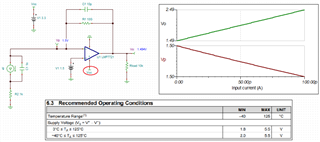
Enclosed is a simulation, where the photodiode current is drew opposite from Vp node, see the linear plot. If it is drew the way you intended, the Vout slope should be decreasing from 1.5Vdc.
Please let me know if power supply rail is the issue.
Best,
Raymond
Hi Raymond,
I supplied 3 V dc using a ref 2030.
The 1.5 V dc bias was applied to the positive input node.
Regards,
Yunsik
Hi Yunsik,
Ok, I simulated the exact configuration you had. You should have 1.5V at Vp or V- input node.
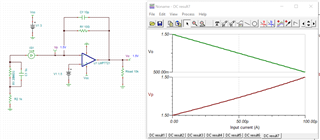
Another possibility is that your Vcm=1.5V has no operating margin. For 2.5V supply, the Vcm (max) is 1.5Vdc. Since you have V+ = 3V, it should be good.

Please check the following:
1. Please check the LMP7721 has not gone bad. (replace with a different one). It sounds like that you may have bad op amp somehow.
2. Make sure that the photodiode is sourcing current, not loading down the inverting node.
Best,
Raymond
Hi Yunsik,
and cleaned them with acetone
Oops, I hope you didn't use acetone for cleaning the assembled PCB actually. Acetone is way too aggressive. Take ethanol or isopropanol.
Kai
Hi Yunsik,
I think this is normal behaviour of an overdriven photodiode TIA circuit. When the output of TIA goes into saturation the photodiode tries to bias itself in forward direction. This would explain why the potential at the -input goes down. This effect is probably mildered by the rather high series resistance of photodiode.
The usual cure is to decrease the 10G feedback resistance and by this to avoid output saturation of TIA.
This happens whenever a photodiode TIA output goes into saturation and should not present a problem in most applications.
Is the issue solved when you entirely shield the detector from ambient light?
Kai
Hi Kai
I think the answer that was not posted on this thread but indicated only by mail is appropriate for explaining this problem.
I am attaching the content that Marek Lis replied.
Marek Lis replied to LMP7721: Amplifier proper operating point.
Yunsik,
The issue is that your circuit has the noise gain of G=501, thus for 1.5V input signal, the output wants to go to 751.5V - see below.
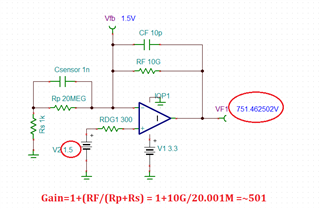
Therefore, the LMP7721 output, Vout ,is stuck at positve rail - see below.

Since there are back-to-back protection diodes between the input terminals (see below), they clamp the inverting input around 0.8V (1.5V-0.7V)
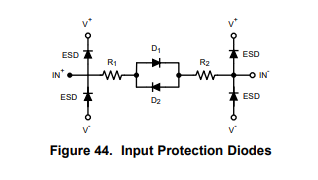
The way to solve the problem is to bias the circuit using either Fig 1 or Fig 2 below.
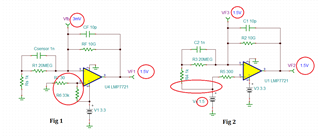
Marek Lis, MGTS
Sr Application Engineer
Precision Analog - TI Tucson
However, it is difficult to use Marek's recommended circuit because the sensor connected to amplifier requires 1.5 V bias.
Yunsik,
Something does not make sense here - please correct the model of the sensor shown below.
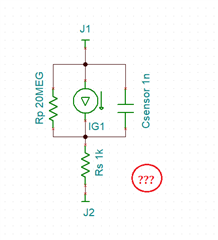
You are attempting to use RF of 10G, implying you try to measure current of up to +/-100pA (delta_Vout=+/-1V), but your Rp of just 20Mohm across IG1 would totally dominate the entire measurement. If the sensor model shown above is correct, you could use this configuration only with RF of 20M by biasing sensor with -1.5V shown below. However, this means your current, IG1, you try to measure would have to be much higher (+/-50nA).
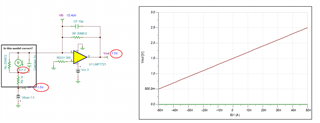
Hi Marek,
Hi, Marek.
It was developed in a laboratory.
What I know about the sensor is the theoretical current value and the value of Rs, Rp, and C.
The theoretical current as follows:
I = Vbias x ΔC x frequency / π
and ΔC = 5 fF / g
When the 100 Hz 2 g peak to peak acceleration signal is entered, the output is 100 Hz 0.48 pA peak to peak current.
Sensor structure and image are below.
Best, Yunsik.
Hi Yunsik,
I think the model from Marek is modelling the sensor quite well:

Correct me if I'm wrong, but the capacitance change of 5fF/g is much smaller than the constant capacitance of 1nF? So a current source in parallel to the 1nF constant capacitance sounds reasonable?
Rs=1k is the resistance of the diaphragm and "doped" polymer material?
And Rp=20M represents the unwanted conductivity of isolation material?
Sounds reasonable to me.
Kai
Hi Kai,
Yes. It sounds reasonable.
The capacitance change is much smaller than the constant capacitance.
The 20-meg ohm parallel resistance is caused by the imperfect isolation of polymeric materials between the upper and lower plates.
Best, Yunsik.
Hi Yunsik,
I have run some simulations and must tell you that unfortunately the very low parallel resistance Rp=20M is a true killer. It's not only the cause of huge bias current flowing through the feedback loop and forbidding a high transimpedance ("gain") but also causes a huge noise because the OPAmp's input voltage noise is amplified by this huge noise gain. And as your signal is super super tiny (in the fA range) the signal will be buried in a sea of noise.
For a proper operation of sensor one would need to tremendeously increase the parallel resistance Rp. But even then the noise will be an issue because the signal is so ultra small.
Kai
Hi Kai,
I can improve the parallel resistance up to Rp=100M.
Yunsik,
Using Rp of 100M with RF of 10M would lower the noise gain from 501 down to G =1+RF/Rp = 1.1 and the circuit would operate linearly, BUT you may have difficulties reading 10uV change (1pA*10M) riding on top of 1.65V DC voltage - see below.
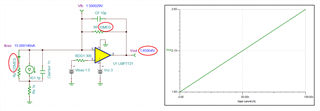
Thus, we need to know what is the minimum IG1 current you need to read? You say that "when 100Hz 2 g peak to peak acceleration signal is entered, the output current is 100 Hz 0.48 pA peak to peak" BUT what is the min resolution and max current range you need to be able to measure?
The main problem with required 1.5V biasing across the sensor with 20M Rp is that it results in 75nA (1.5V/20M) DC bias current (see below) making it nearly impossible to measure 1pA change (75nA/1pA = 75,000) since it will be well within the noise of the measurement, ~0.001% so heavy filtering would be required..
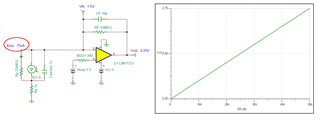
Increasing Rp to 100Mohm (I'm not sure if this is even possible) would lower the DC bias to 15nA, thus improving the resolution of 1pA current by 5x. However, this means that you still would need to be able to measure 50uV change (assuming 1pA increased current) riding on top of 2.25VDC bias voltage - see below.
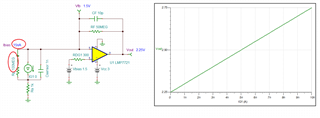
Below I attached Tina-TI schematic for your own simulations.